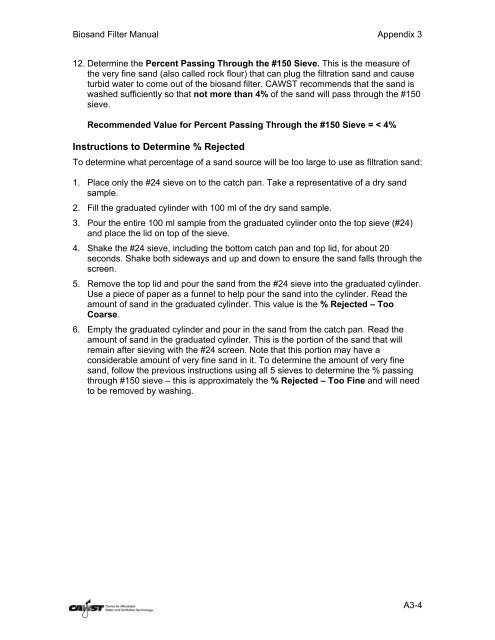Appendix 3: Sand Sieve Analysis - CAWST
Appendix 3: Sand Sieve Analysis - CAWST
Appendix 3: Sand Sieve Analysis - CAWST
You also want an ePaper? Increase the reach of your titles
YUMPU automatically turns print PDFs into web optimized ePapers that Google loves.
Biosand Filter Manual <strong>Appendix</strong> 3<br />
12. Determine the Percent Passing Through the #150 <strong>Sieve</strong>. This is the measure of<br />
the very fine sand (also called rock flour) that can plug the filtration sand and cause<br />
turbid water to come out of the biosand filter. <strong>CAWST</strong> recommends that the sand is<br />
washed sufficiently so that not more than 4% of the sand will pass through the #150<br />
sieve.<br />
Recommended Value for Percent Passing Through the #150 <strong>Sieve</strong> = < 4%<br />
Instructions to Determine % Rejected<br />
To determine what percentage of a sand source will be too large to use as filtration sand:<br />
1. Place only the #24 sieve on to the catch pan. Take a representative of a dry sand<br />
sample.<br />
2. Fill the graduated cylinder with 100 ml of the dry sand sample.<br />
3. Pour the entire 100 ml sample from the graduated cylinder onto the top sieve (#24)<br />
and place the lid on top of the sieve.<br />
4. Shake the #24 sieve, including the bottom catch pan and top lid, for about 20<br />
seconds. Shake both sideways and up and down to ensure the sand falls through the<br />
screen.<br />
5. Remove the top lid and pour the sand from the #24 sieve into the graduated cylinder.<br />
Use a piece of paper as a funnel to help pour the sand into the cylinder. Read the<br />
amount of sand in the graduated cylinder. This value is the % Rejected – Too<br />
Coarse.<br />
6. Empty the graduated cylinder and pour in the sand from the catch pan. Read the<br />
amount of sand in the graduated cylinder. This is the portion of the sand that will<br />
remain after sieving with the #24 screen. Note that this portion may have a<br />
considerable amount of very fine sand in it. To determine the amount of very fine<br />
sand, follow the previous instructions using all 5 sieves to determine the % passing<br />
through #150 sieve – this is approximately the % Rejected – Too Fine and will need<br />
to be removed by washing.<br />
A3-4


